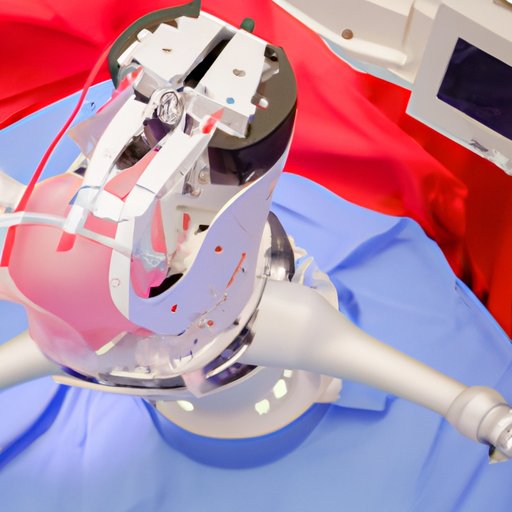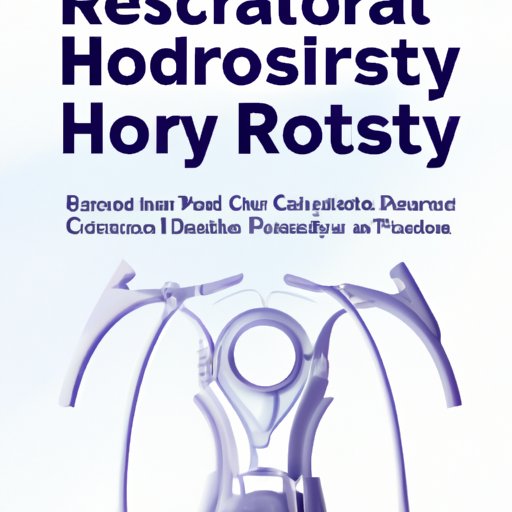Introduction
A hysterectomy is a surgical procedure to remove the uterus, or womb, from a woman’s body. It is a major surgery that can have significant physical and emotional consequences for the patient. In recent years, advances in medical technology have allowed for the development of robotic hysterectomy, a minimally invasive procedure that offers many benefits over traditional hysterectomy methods.
Robotic hysterectomy is a type of laparoscopic hysterectomy that uses robotic technology to allow a surgeon to perform the operation with greater precision and control. Robotic hysterectomy is a major breakthrough in the field of gynecological surgery because it allows surgeons to perform complex surgeries with minimal risk to the patient.

The Breakthrough Technology Behind Robotic Hysterectomy
Robotic hysterectomy is performed using a robotic surgical system, which is a computer-controlled device that provides the surgeon with greater precision and accuracy during the procedure. The system consists of three parts: a console where the surgeon sits and controls the robot, a robotic arm that holds the surgical instruments, and a camera that allows the surgeon to view the operative site.
The robotic arm is equipped with a variety of instruments, including scissors, forceps, and lasers, that allow the surgeon to perform delicate and precise maneuvers. The robot is also able to make small incisions and suture them closed without the need for large incisions, resulting in less trauma to the patient.
This technology has revolutionized the way hysterectomies are performed. According to one study, “Robotic hysterectomy is associated with shorter hospital stays, fewer complications, faster recovery times, and improved quality of life compared to traditional approaches.”

A Comprehensive Guide to Robotic Hysterectomy
Robotic hysterectomy is a complex process that requires careful preparation and follow-up care. Here is a comprehensive guide to what you need to know about the procedure:
Pre-operative Preparation
Before the procedure, the patient will need to undergo a series of tests and consultations with the doctor to ensure the procedure is safe and appropriate for her individual circumstances. During this time, the patient should ask questions to ensure she fully understands the procedure, risks, and alternatives.
Steps During the Procedure
Once the pre-operative preparations are complete, the patient will be taken to the operating room. Here, the surgeon will make a few small incisions in the abdomen and insert the robotic arms into the body. The surgeon will then use the robotic arms to carefully remove the uterus and any other reproductive organs that may need to be removed.
Post-operative Care and Recovery
After the procedure, the patient will need to take some time off work to rest and recover. During this time, the patient should follow their doctor’s instructions for post-operative care and monitor their symptoms closely. The patient should also attend regular follow-up appointments to ensure the healing process is progressing as expected.
Comparing Traditional vs. Robotic Hysterectomy
Both traditional and robotic hysterectomies are used to treat a variety of gynecological conditions, but there are important differences between the two procedures. Here is a comparison of the benefits and risks associated with each:
Benefits of Traditional Hysterectomy
Traditional hysterectomy is a reliable and well-established procedure. It is often recommended for women who need to have their uterus removed due to cancer or other serious medical conditions. Traditional hysterectomy also has a lower risk of complications than robotic hysterectomy.
Benefits of Robotic Hysterectomy
Robotic hysterectomy is a minimally invasive procedure that results in less pain and trauma to the patient. Additionally, it has a shorter recovery time and is associated with fewer complications than traditional hysterectomy.
Comparison of Risks Associated with Traditional and Robotic Hysterectomy
Both traditional and robotic hysterectomy carry risks, including infection, blood loss, and damage to surrounding organs. However, robotic hysterectomy carries a lower risk of these complications due to its minimally invasive nature. Additionally, robotic hysterectomy is associated with a lower risk of urinary incontinence and sexual dysfunction than traditional hysterectomy.

What You Need to Know About Robotic Hysterectomy
Robotic hysterectomy is a major surgical procedure, so it is important to understand the different types of hysterectomies available, the possible side effects of the procedure, and the cost considerations. Here is what you need to know:
Different Types of Hysterectomies
There are several different types of hysterectomies, including total hysterectomy, partial hysterectomy, radical hysterectomy, and subtotal hysterectomy. Each type of hysterectomy has its own advantages and disadvantages, and it is important to discuss the options with your doctor before making a decision.
Possible Side Effects of Robotic Hysterectomy
Robotic hysterectomy is generally a safe and effective procedure, but as with any major surgery, it carries certain risks. Common side effects include pain, bleeding, infection, and scarring. Additionally, some women may experience changes in their sexual function or urinary incontinence after the procedure.
Cost Considerations
Robotic hysterectomy can be costly, and the exact cost will depend on the type of procedure, the hospital or clinic where it is performed, and the patient’s insurance coverage. It is important to discuss costs with your doctor before scheduling the procedure.
Alternatives to Robotic Hysterectomy
In some cases, robotic hysterectomy may not be the best option for a patient. Alternatives to robotic hysterectomy include laparoscopic hysterectomy, vaginal hysterectomy, and abdominal hysterectomy. These alternatives may offer similar benefits with fewer risks and a shorter recovery time.
Conclusion
Robotic hysterectomy is a major breakthrough in the field of gynecological surgery. It is a minimally invasive procedure that offers many benefits over traditional methods, including shorter hospital stays, fewer complications, faster recovery times, and improved quality of life. However, it is important to understand the potential risks and side effects of the procedure and to discuss the options with your doctor before deciding whether robotic hysterectomy is the right choice for you.
(Note: Is this article not meeting your expectations? Do you have knowledge or insights to share? Unlock new opportunities and expand your reach by joining our authors team. Click Registration to join us and share your expertise with our readers.)
